Adaptive Fault-Tolerant Tracking Control for Continuous-Time Interval Type-2 Fuzzy Systems
Abstract
:1. Introduction
- Considering the membership function mismatch and uncertainty of each part in the practical system, the proposed design scheme is aimed at the tracking problem of a mixed and adaptive FTC for continuous-time IT2FSs.
- Compared with the general adaptive FTC scheme in [11,13], the adaptive control function is improved in this paper, which is simultaneously tolerant of the sensor and the actuator faults. Based on the adaptive signal, the dynamic parameters in the disturbance compensation term can be dynamically adjusted to achieve a better FTC effect.
- Mixed and performance is considered in the design of the fuzzy tracking controller and observer to meet a wider range of practical requirements. Based on the matrix inequality transformation technique in the lemmas, the designed algorithm reduces conservatism by introducing suitable slack variables and matrices in the theorem.
2. Problem Statement and Preliminarie
2.1. Continuous-Time IT2FSs
2.2. Reference Model
2.3. IT2 Fuzzy Observer
2.4. IT2 Fuzzy Adaptive Tracking Controller
2.5. Adaptive FTC System
3. Adaptive FTC System Performance Analysis
4. Fuzzy Observer and Controller Design
5. Simulations
6. Conclusions
Author Contributions
Funding
Data Availability Statement
Conflicts of Interest
References
- Witczak, M. Fault Diagnosis and Fault-Tolerant Control Strategies for Non-Linear Systems; Springer: Heidelberg, Germany, 2014. [Google Scholar]
- Long, Y.; Park, J.H.; Ye, D. Asynchronous fault detection and isolation for Markov jump systems with actuator failures under networked environment. IEEE Trans. Syst. Man, Cybern. Syst. 2021, 51, 3477–3487. [Google Scholar] [CrossRef]
- Zhu, Z.; Zhu, Q. Adaptive event-triggered fuzzy control for stochastic highly nonlinear systems with time delay and non-triangular structure interconnections. IEEE Trans. Fuzzy Syst. 2024, 32, 27–37. [Google Scholar] [CrossRef]
- Wang, X. Active fault tolerant control for unmanned underwater vehicle with sensor faults. IEEE Trans. Instrum. Meas. 2020, 69, 9485–9495. [Google Scholar] [CrossRef]
- Han, S.Y.; Zhou, J.; Chen, Y.H.; Zhang, Y.F.; Tang, G.y.; Wang, L. Active fault-tolerant control for discrete vehicle active suspension via reduced-order observer. IEEE Trans. Syst. Man, Cybern. Syst. 2021, 51, 6701–6711. [Google Scholar] [CrossRef]
- Rudin, K.; Ducard, G.J.J.; Siegwart, R.Y. Active fault-tolerant control with imperfect fault detection information: Applications to UAVs. IEEE Trans. Aerosp. Electron. Syst. 2020, 56, 2792–2805. [Google Scholar] [CrossRef]
- Zhang, K.; Jiang, B.; Yan, X.; Mao, Z.; Polycarpou, M.M. Fault-tolerant control for systems with unmatched actuator faults and disturbances. IEEE Trans. Autom. Control 2021, 66, 1725–1732. [Google Scholar] [CrossRef]
- Mu, Y.; Zhang, H.; Xi, R.; Wang, Z.; Sun, J. Fault-tolerant control of nonlinear systems with actuator and sensor faults based on T–S fuzzy model and fuzzy observer. IEEE Trans. Syst. Man Cybern. Syst. 2022, 52, 5795–5804. [Google Scholar] [CrossRef]
- Li, X.; Song, W.; Li, Y.; Tong, S. Finite-time dynamic event-triggered fuzzy output fault-tolerant control for interval type-2 fuzzy systems. IEEE Trans. Fuzzy Syst. 2022, 30, 4926–4938. [Google Scholar] [CrossRef]
- Zhu, X.; Li, W.; Xia, Y. Finite-time fault estimate and fault-tolerant control for discrete-time Markov jump systems with actuator and sensor faults. Int. J. Robust Nonlinear Control 2023, 33, 6233–6249. [Google Scholar] [CrossRef]
- Jin, X.Z.; Yang, G.H. Robust adaptive fault-tolerant compensation control with actuator failures and bounded disturbances. Acta Autom. Sin. 2009, 35, 305–309. [Google Scholar] [CrossRef]
- Bounemeur, A.; Chemachema, M. Adaptive fuzzy fault-tolerant control using Nussbaum-type function with state-dependent actuator failures. Neural Comput. Appl. 2021, 33, 191–208. [Google Scholar] [CrossRef]
- Jin, X.Z.; Che, W.W.; Wu, Z.G.; Wang, H. Analog control circuit designs for a class of continuous-time adaptive fault-tolerant control systems. IEEE Trans. Cybern. 2022, 52, 4209–4220. [Google Scholar] [CrossRef] [PubMed]
- Zhao, Z.; Tan, Z.; Liu, Z.; Efe, M.O.; Ahn, C.K. Adaptive inverse compensation fault-tolerant control for a flexible manipulator with unknown dead-zone and actuator faults. IEEE Trans. Ind. Electron. 2023, 70, 12698–12707. [Google Scholar] [CrossRef]
- Chen, C.; Lewis, F.L.; Xie, S.; Modares, H.; Liu, Z.; Zuo, S.; Davoudi, A. Resilient adaptive and controls of multi-agent systems under sensor and actuator faults. Automatica 2019, 102, 19–26. [Google Scholar] [CrossRef]
- Tahoun, A.H.; Arafa, M. A new unmatched-disturbances compensation and fault-tolerant control for partially known nonlinear singular systems. ISA Trans. 2020, 104, 310–320. [Google Scholar] [CrossRef]
- Wang, B.; Zhang, Y. An adaptive fault-tolerant sliding mode control allocation scheme for multirotor helicopter subject to simultaneous actuator faults. IEEE Trans. Ind. Electron. 2018, 65, 4227–4236. [Google Scholar] [CrossRef]
- Bey, O.; Chemachema, M. Finite-time event-triggered output-feedback adaptive decentralized echo-state network fault-tolerant control for interconnected pure-feedback nonlinear systems with input saturation and external disturbances: A fuzzy control-error approach. Inf. Sci. 2024, 669, 120557. [Google Scholar] [CrossRef]
- Li, H.; Wu, Y.; Chen, M. Adaptive fault-tolerant tracking control for discrete-time multiagent systems via reinforcement learning algorithm. IEEE Trans. Cybern. 2021, 51, 1163–1174. [Google Scholar] [CrossRef]
- Zare, I.; Setoodeh, P.; Asemani, M.H. Fault-tolerant tracking control of discrete-time T–S fuzzy systems with input constraint. IEEE Trans. Fuzzy Syst. 2022, 30, 1914–1928. [Google Scholar] [CrossRef]
- Liu, X.M.; Chang, X.H. Adaptive event-triggered tracking control for nonlinear networked systems with dynamic quantization and deception attacks. Int. J. Robust Nonlinear Control 2024, 34, 8311–8333. [Google Scholar] [CrossRef]
- Zou, A.M.; Kumar, K.D.; Ruiter, A.H.J.d. Fixed-time attitude tracking control for rigid spacecraft. Automatica 2020, 113, 108792. [Google Scholar] [CrossRef]
- Lee, H.; Kim, H.J. Trajectory tracking control of multirotors from modelling to experiments: A survey. Int. J. Control. Autom. Syst. 2017, 15, 281–292. [Google Scholar] [CrossRef]
- Amer, N.H.; Zamzuri, H.; Hudha, K.; Kadir, Z.A. Modelling and control strategies in path tracking control for autonomous ground vehicles: A review of state of the art and challenges. J. Intell. Robot. Syst. 2017, 85, 225–254. [Google Scholar] [CrossRef]
- Li, W.; Xie, Z.; Wong, P.K.; Zhang, X.; Zhao, J.; Zhao, J. Interval type-2 fuzzy path tracking control for autonomous ground vehicles under switched triggered and sensor attacks. IEEE Trans. Intell. Transp. Syst. 2024, 25, 16024–16035. [Google Scholar] [CrossRef]
- Chang, X.H.; Han, X. Observer-based fuzzy l2 − l∞ control for discrete-time nonlinear systems. IEEE Trans. Fuzzy Syst. 2024, 32, 2523–2528. [Google Scholar] [CrossRef]
- Chang, X.H.; Liu, X.M.; Hou, L.W.; Qi, J.H. Quantized fuzzy feedback control for electric vehicle lateral dynamics. IEEE Trans. Syst. Man Cybern. Syst. 2024, 54, 2331–2341. [Google Scholar] [CrossRef]
- Liu, H.; Wang, Z.; Fei, W.; Li, J. and l2 − l∞ state estimation for delayed memristive neural networks on finite horizon: The Round-Robin protocol. Neural Netw. 2020, 132, 121–130. [Google Scholar] [CrossRef]
- Zhang, Z.; Dong, J. Observer-based interval type-2 L2 − L∞/mixed fuzzy control for uncertain nonlinear systems under measurement outliers. IEEE Trans. Syst. Man Cybern. Syst. 2021, 51, 7652–7662. [Google Scholar] [CrossRef]
- Zhu, Q. Event-triggered sampling problem for exponential stability of stochastic nonlinear delay systems driven by Levy processes. IEEE Trans. Autom. Control 2024, 1–8. [Google Scholar] [CrossRef]
- Zhu, Q. Stabilization of stochastic nonlinear delay systems with exogenous disturbances and the event-triggered feedback control. IEEE Trans. Autom. Control 2019, 64, 3764–3771. [Google Scholar] [CrossRef]
- Takagi, T.; Sugeno, M. Fuzzy identification of systems and its application to modeling and control. IEEE Trans. Syst. Man Cybern. 1985, SMC-15, 116–132. [Google Scholar] [CrossRef]
- Zhao, X.Y.; Chang, X.H. filtering for nonlinear discrete-time singular systems in encrypted state. Neural Process. Lett. 2022, 55, 2843–2866. [Google Scholar] [CrossRef]
- Mendel, J.M.; John, R.I.; Liu, F. Interval type-2 fuzzy logic systems made simple. IEEE Trans. Fuzzy Syst. 2006, 14, 808–821. [Google Scholar] [CrossRef]
- Li, X.; Ye, D. Asynchronous event-triggered control for networked interval type-2 fuzzy systems against DoS attacks. IEEE Trans. Fuzzy Syst. 2021, 29, 262–274. [Google Scholar] [CrossRef]
- Ge, C.; Sun, R.; Liu, Y.; Feng, W. Interval type-2 fuzzy sampled-date control for nonlinear systems with packet dropouts via a switched system approach. Int. J. Fuzzy Syst. 2024. [Google Scholar] [CrossRef]
- Pan, Y.; Yang, G.H. Event-driven fault detection for discrete-time interval type-2 fuzzy systems. IEEE Trans. Syst. Man Cybern. Syst. 2021, 51, 4959–4968. [Google Scholar] [CrossRef]
- Zhang, Z.; Su, S.F.; Niu, Y. Dynamic event-triggered control for interval type-2 fuzzy systems under fading channel. IEEE Trans. Cybern. 2021, 51, 5342–5351. [Google Scholar] [CrossRef]
- Tang, X.; Wu, M.; Li, M.; Ding, B. On designing the event-triggered multistep model predictive control for nonlinear system over networks with packet dropouts and cyber attacks. IEEE Trans. Cybern. 2022, 52, 11200–11212. [Google Scholar] [CrossRef]
- Zhang, X.; Huang, W. Adaptive sliding mode fault tolerant control for interval type-2 fuzzy singular fractional-order systems. J. Vib. Control 2022, 28, 465–475. [Google Scholar] [CrossRef]
- Feng, Z.; Yang, Y.; Lam, H.K. Extended-dissipativity-based adaptive event-triggered control for stochastic polynomial fuzzy singular systems. IEEE Trans. Fuzzy Syst. 2022, 30, 3224–3236. [Google Scholar] [CrossRef]
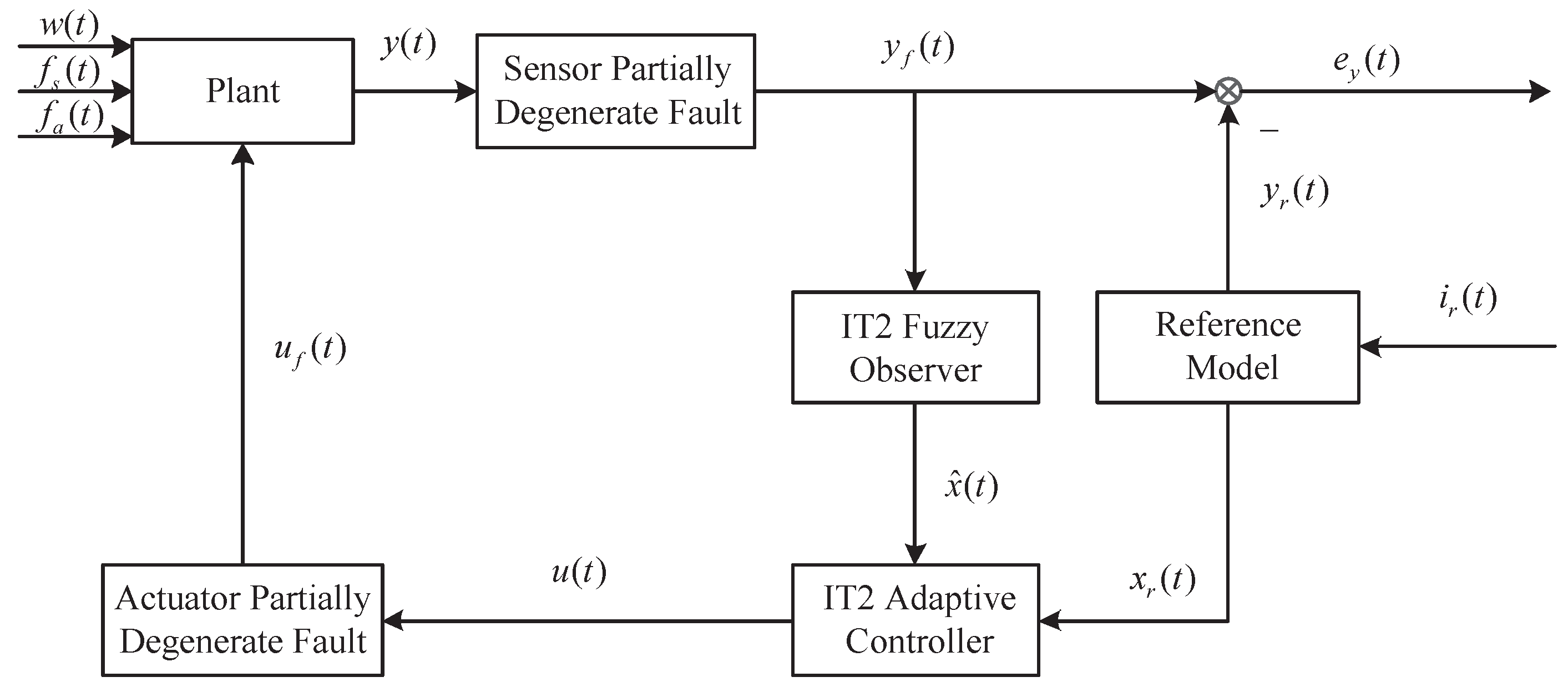
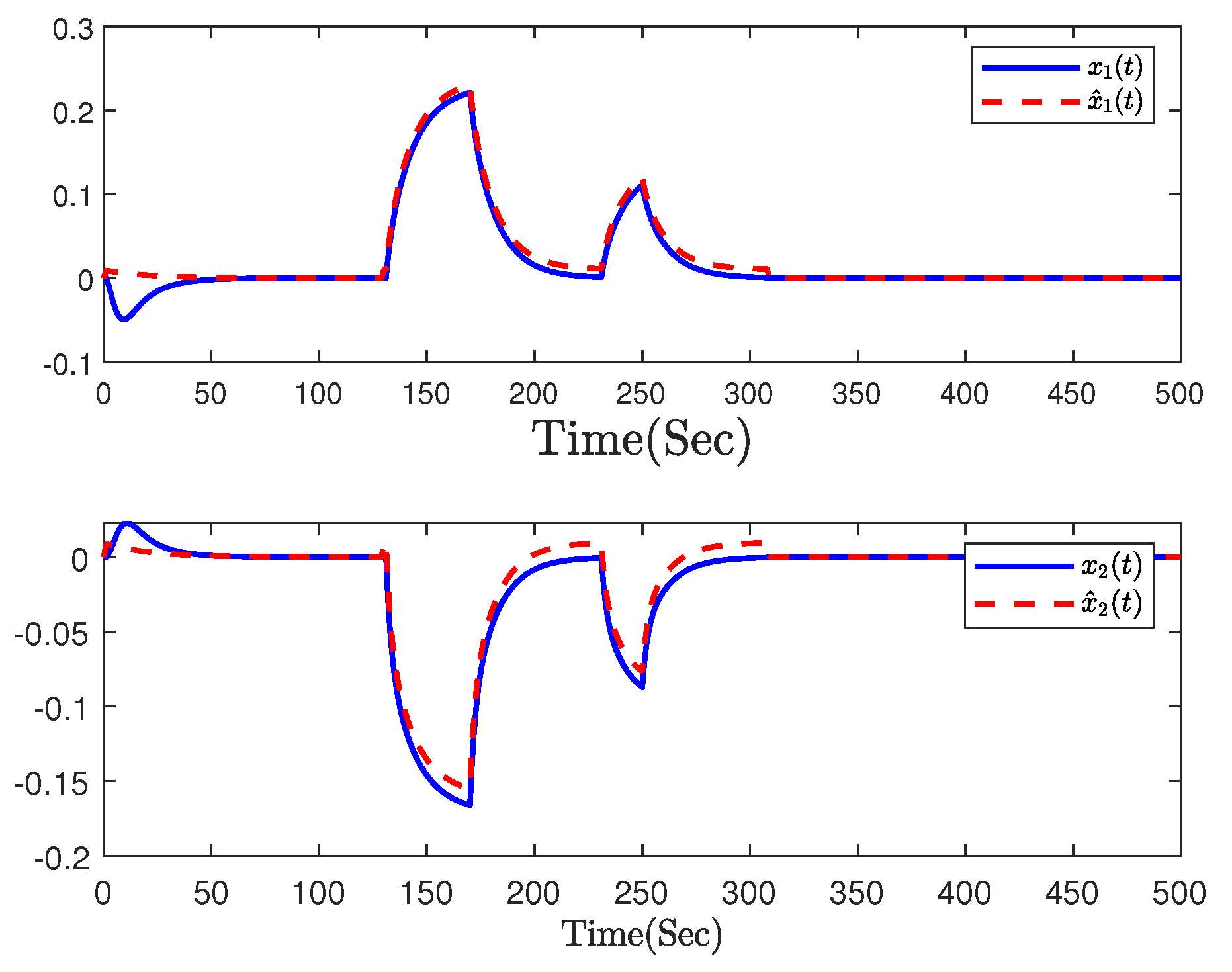
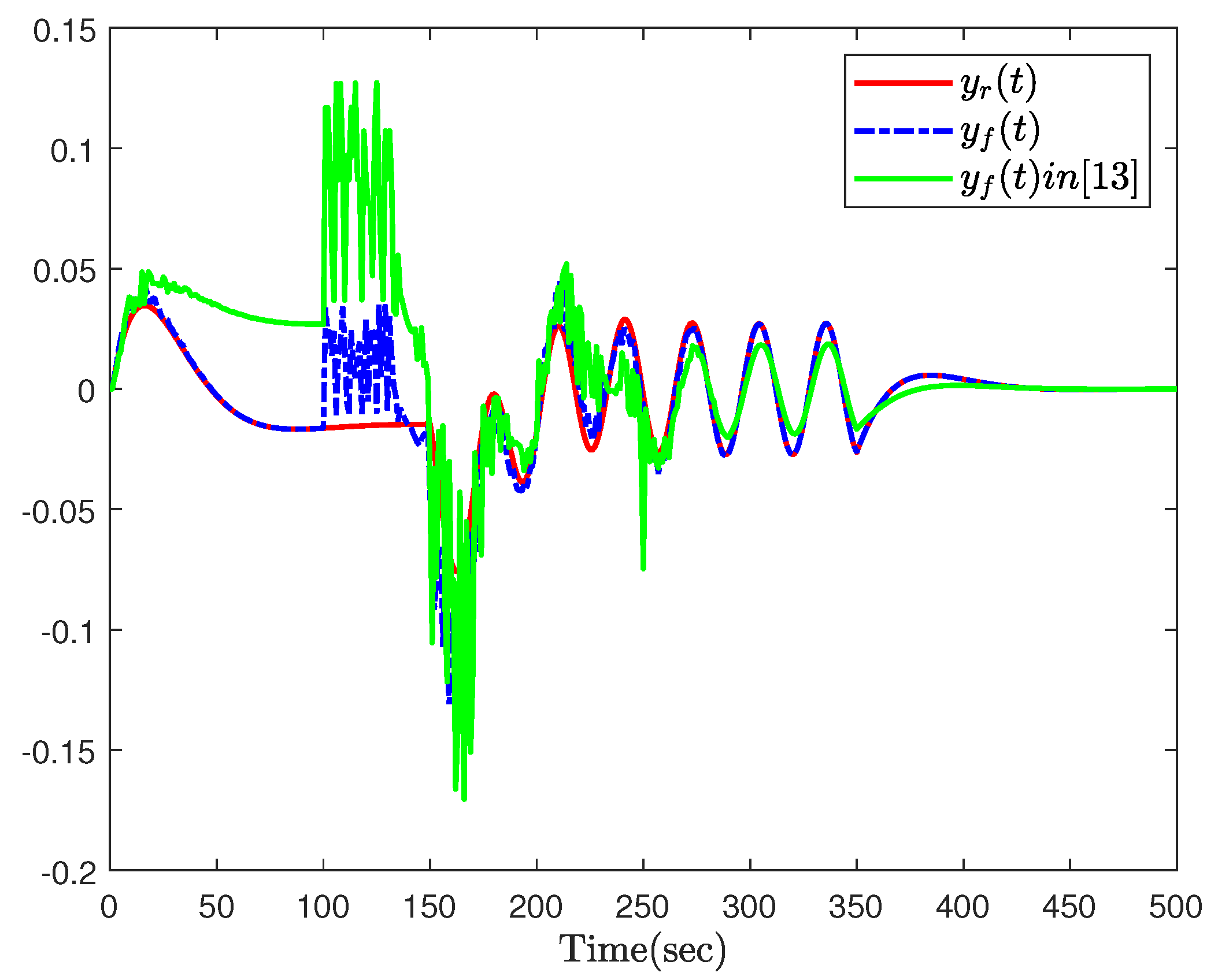
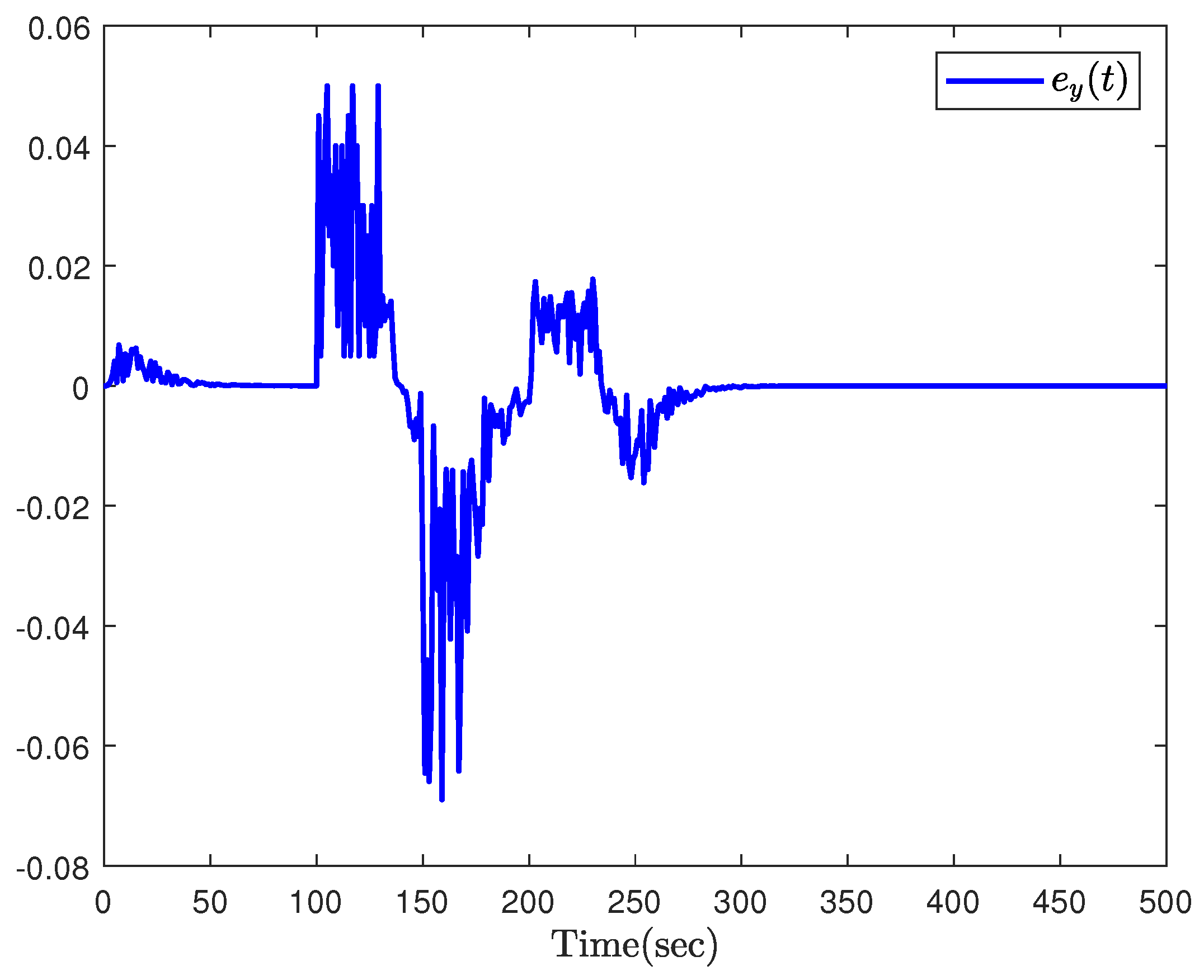
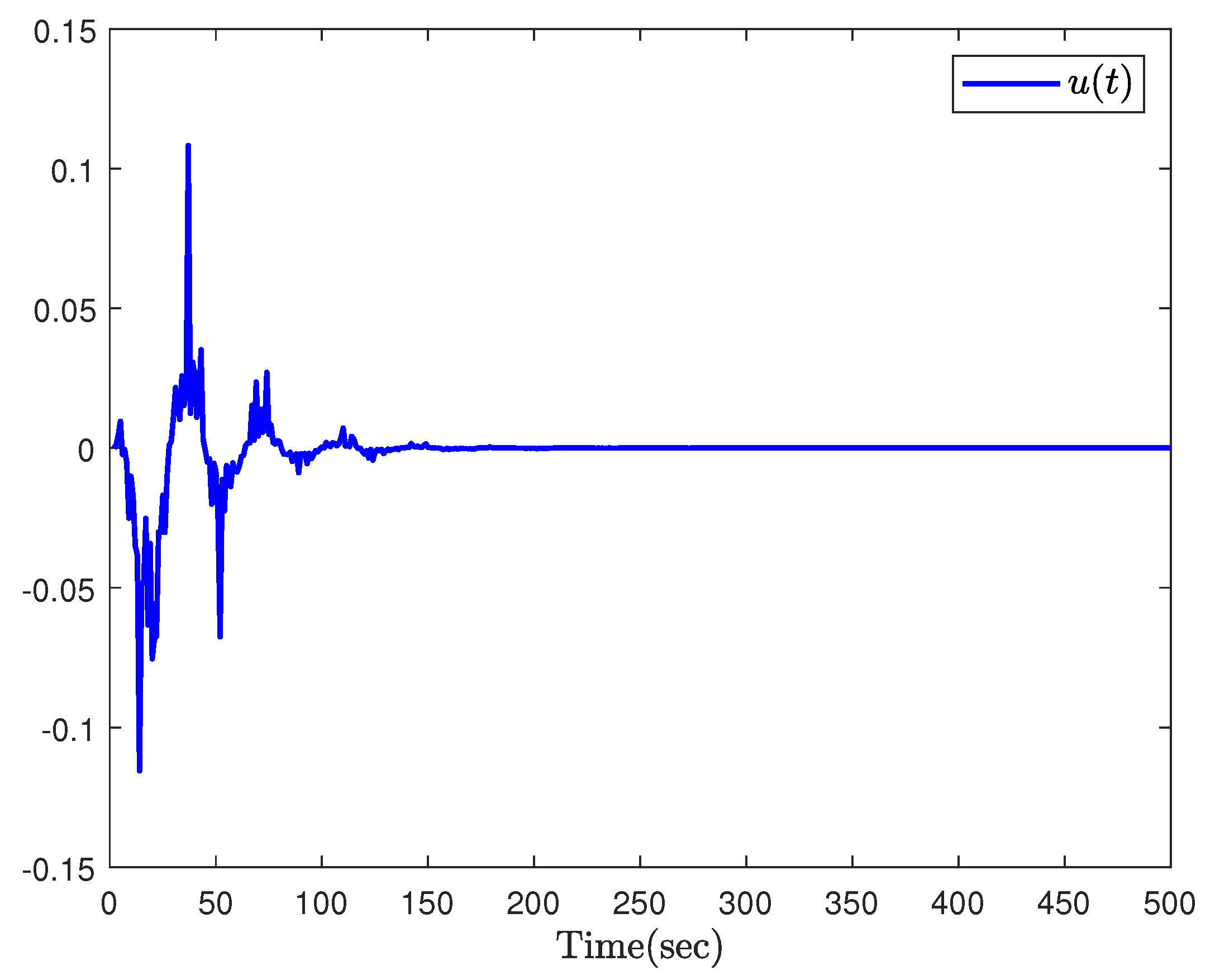
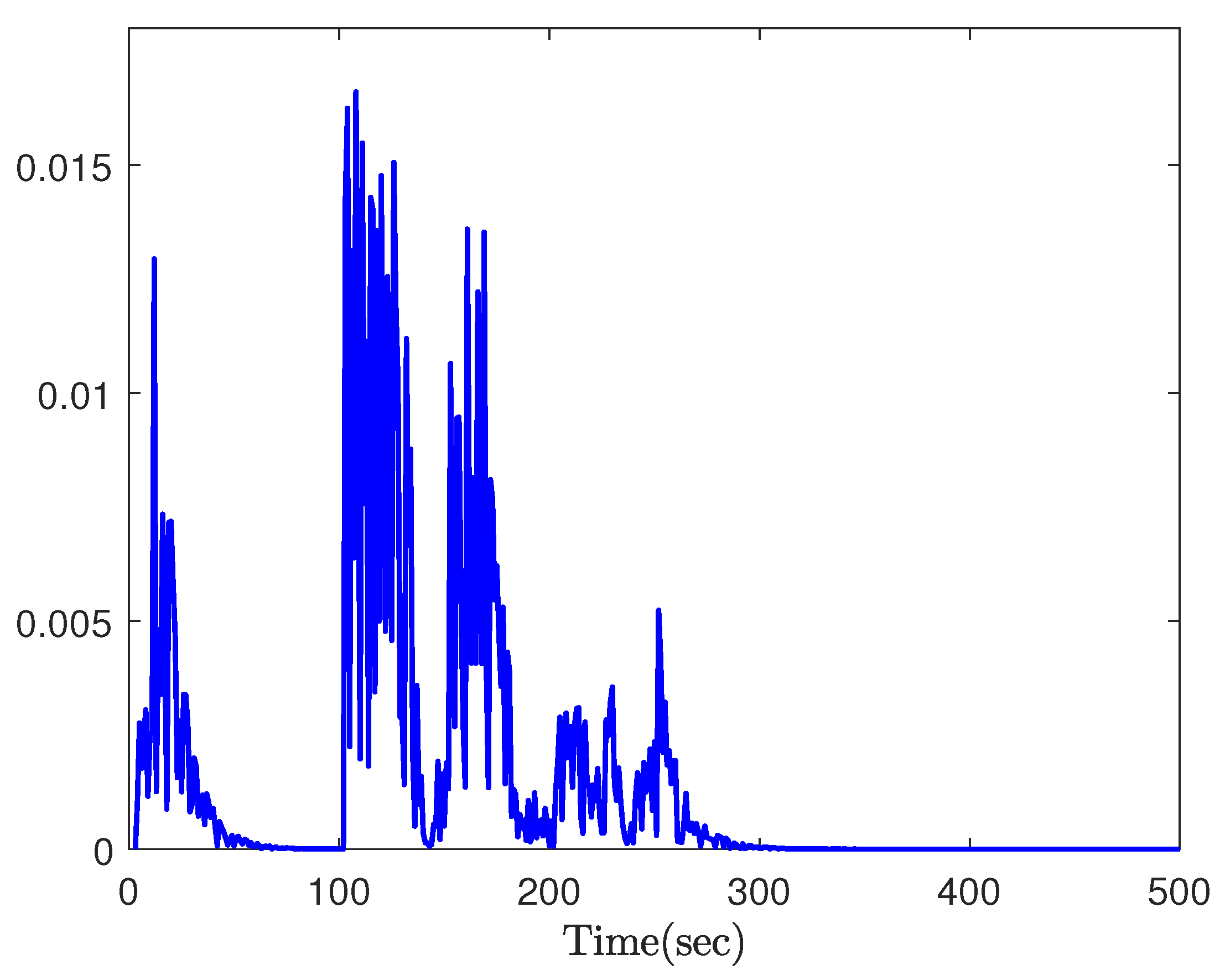

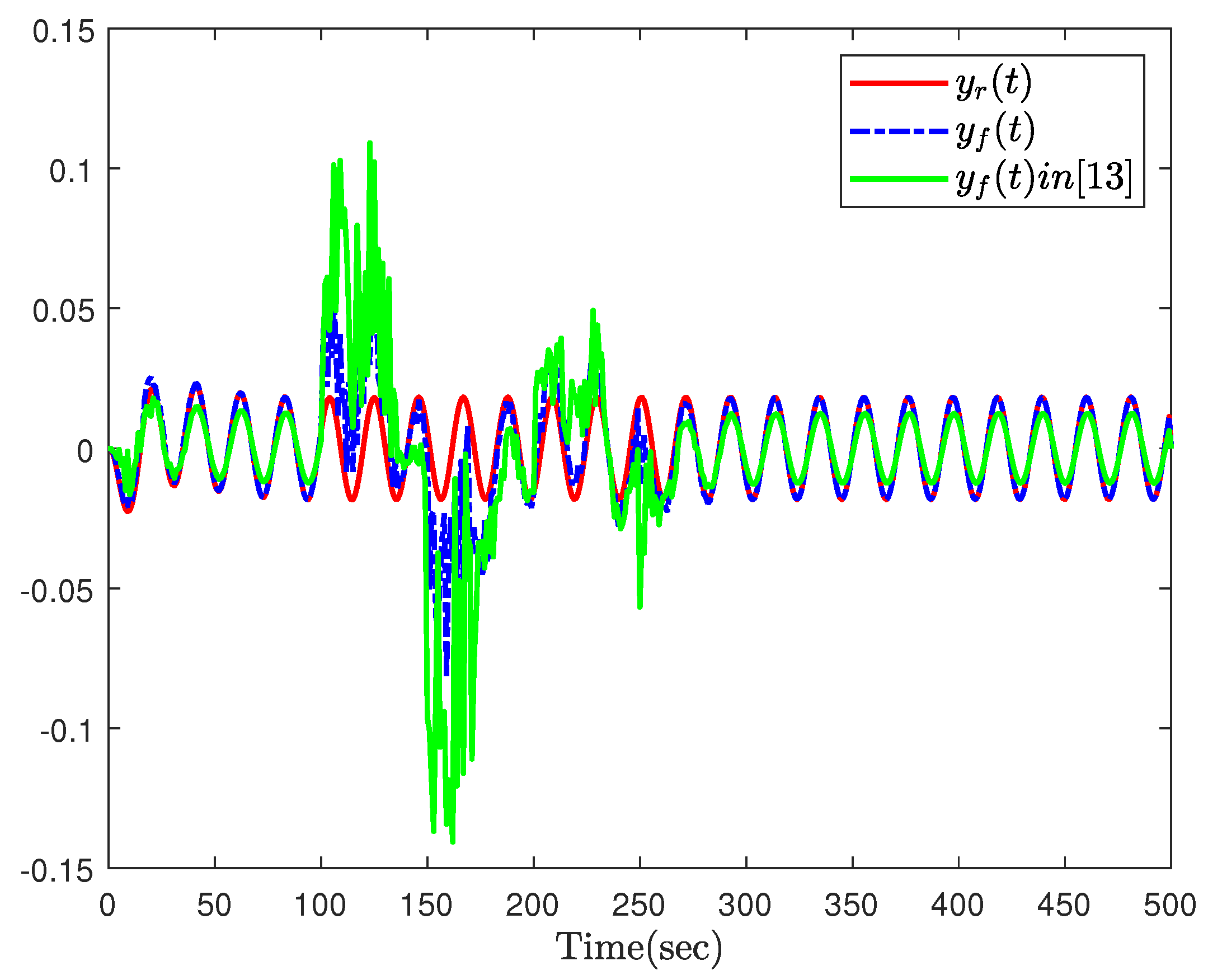
Disclaimer/Publisher’s Note: The statements, opinions and data contained in all publications are solely those of the individual author(s) and contributor(s) and not of MDPI and/or the editor(s). MDPI and/or the editor(s) disclaim responsibility for any injury to people or property resulting from any ideas, methods, instructions or products referred to in the content. |
© 2024 by the authors. Licensee MDPI, Basel, Switzerland. This article is an open access article distributed under the terms and conditions of the Creative Commons Attribution (CC BY) license (https://creativecommons.org/licenses/by/4.0/).
Share and Cite
Qiao, M.-Y.; Chang, X.-H. Adaptive Fault-Tolerant Tracking Control for Continuous-Time Interval Type-2 Fuzzy Systems. Mathematics 2024, 12, 3682. https://doi.org/10.3390/math12233682
Qiao M-Y, Chang X-H. Adaptive Fault-Tolerant Tracking Control for Continuous-Time Interval Type-2 Fuzzy Systems. Mathematics. 2024; 12(23):3682. https://doi.org/10.3390/math12233682
Chicago/Turabian StyleQiao, Ming-Yang, and Xiao-Heng Chang. 2024. "Adaptive Fault-Tolerant Tracking Control for Continuous-Time Interval Type-2 Fuzzy Systems" Mathematics 12, no. 23: 3682. https://doi.org/10.3390/math12233682
APA StyleQiao, M.-Y., & Chang, X.-H. (2024). Adaptive Fault-Tolerant Tracking Control for Continuous-Time Interval Type-2 Fuzzy Systems. Mathematics, 12(23), 3682. https://doi.org/10.3390/math12233682





